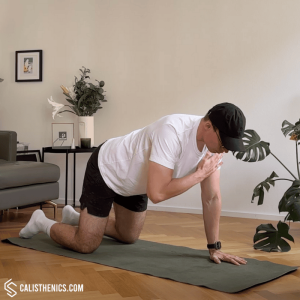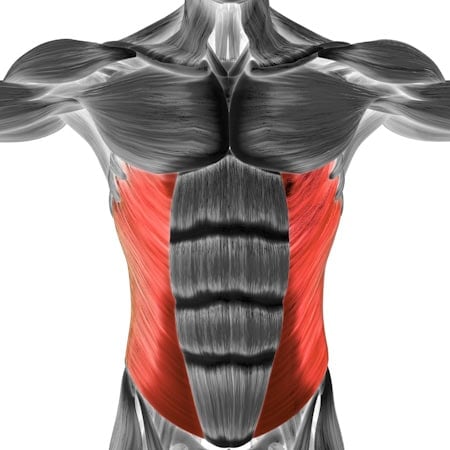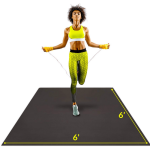Kneeling Shoulder Taps
How to do Kneeling Shoulder Taps?
Kneeling shoulder taps are a modified version of the traditional shoulder taps performed from a plank position. This exercise engages the core, shoulders, and stabilizers while minimizing the intensity on the wrists and lower back. By tapping each shoulder alternately while maintaining balance on the knees and hands, this movement enhances core stability, shoulder strength, and body coordination. It’s ideal for beginners or those recovering from injury, offering a lower-intensity variation while still providing an effective workout for the upper body and core.
Steps to Perform a Proper Kneeling Shoulder Tap:
1. Starting Position (Kneeling):
• Begin on all fours with your hands directly under your shoulders and knees on the floor, hip-width apart. Your body should form a straight line from your head to your knees.
• Engage your core by pulling your belly button toward your spine, maintaining a flat back and a neutral neck position, looking down at the floor.
2. Lift One Hand to Tap Opposite Shoulder:
• Exhale as you lift your right hand off the floor and tap your left shoulder, keeping your hips and torso as still as possible. Focus on engaging your core to prevent your hips from swaying or rotating.
• Your body should remain stable, and only the arm should move.
3. Return to Starting Position:
• Inhale as you place your right hand back on the floor. Make sure to lower it in a controlled manner without shifting your hips or losing balance.
4. Repeat on the Opposite Side:
• Lift your left hand and tap your right shoulder, again keeping your body stable and your core engaged. Focus on minimizing movement in your hips and torso.
• Continue alternating sides, performing the desired number of repetitions.
Benefits of Kneeling Shoulder Taps
• Improves Core Stability: By engaging the core to prevent rotation, kneeling shoulder taps strengthen the abdominals and obliques, improving overall core stability.
• Enhances Shoulder Strength: The shoulders are actively engaged throughout the movement, helping to build strength and endurance in the deltoids and upper body.
• Promotes Balance and Coordination: This exercise requires coordination between the upper body and core, helping to improve balance and body awareness.
• Supports Injury Recovery: The reduced intensity makes kneeling shoulder taps ideal for individuals recovering from shoulder or lower back injuries, offering a low-impact way to strengthen the core and upper body.
• Improves Posture: Strengthening the core and shoulders through shoulder taps helps support better posture by stabilizing the spine and engaging the muscles that contribute to good alignment.
• Low Impact: This exercise is easy on the joints, making it suitable for all fitness levels, especially for beginners or those looking for a gentler core and upper body workout.
• Builds a Foundation for More Advanced Movements: Kneeling shoulder taps are a great stepping stone toward more advanced exercises, such as full plank shoulder taps, side planks, or other core stability movements.
Common Mistakes to Avoid
• Letting the Hips Sway: One of the key focuses of this exercise is maintaining hip stability. Avoid allowing your hips to shift or rotate as you lift your hands to tap your shoulders.
• Arching or Sagging the Back: Keep your back flat and core engaged. Avoid arching your lower back or letting your stomach drop toward the ground, which can put strain on your spine.
• Rushing Through the Movement: Avoid performing the taps too quickly, as this reduces the effectiveness of the exercise. Focus on slow, controlled movements to engage the correct muscles.
• Holding Your Breath: Don’t forget to breathe! Steady, controlled breathing helps maintain core engagement and supports the movement.
Tips for the proper execution of Kneeling Shoulder Taps
Core Engagement: Keep your core tight throughout the movement to prevent your hips from swaying side to side. This is key for maintaining stability and maximizing the effectiveness of the exercise.
Controlled Movement: Perform each tap slowly and with control. Avoid rushing through the exercise, as this can lead to instability and compromise form.
Maintain Neutral Spine: Ensure that your back stays flat, with a straight line from your head to your knees. Avoid arching or rounding your back.
Knee and Hand Positioning: Keep your knees slightly behind your hips and your hands under your shoulders for proper alignment and stability.
Breathing: Exhale as you lift your hand to tap your shoulder, and inhale as you return your hand to the ground. Steady breathing helps maintain control and focus during the movement.
Muscles worked when doing Kneeling Shoulder Taps
Primary Muscles:
•Core: Abdominals and obliques (for stabilization)
•Shoulders: Deltoids (engaged to support the upper body during the taps)
•Chest: Pectoralis major (assists in stabilizing the body and supporting the shoulder taps)
Secondary Muscles:
•Lower Back: Erector spinae muscles help stabilize the spine and maintain proper posture.
•Glutes: Engaged to help stabilize the hips and prevent rotation.
•Triceps: Help stabilize the arms during the taps.
•Quadriceps: Assist in maintaining stability in the kneeling position.
Primary Muscle(s):
Secondary Muscle(s):
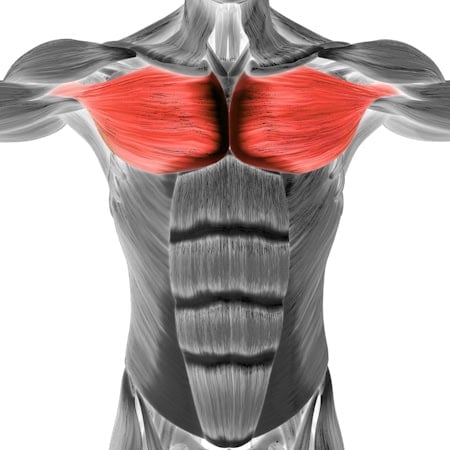
Middle chest
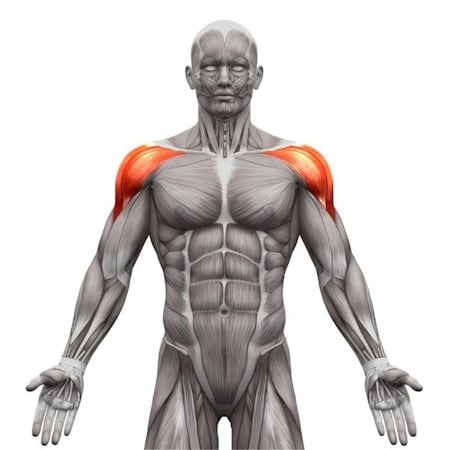
Anterior delt
Adjust the difficulty of Kneeling Shoulder Taps
How to make Kneeling Shoulder Taps harder?
How to make Kneeling Shoulder Taps easier?
How to make Kneeling Shoulder Taps harder?
To make Kneeling Shoulder Taps harder:
-
Narrow Your Knees: Bring your knees closer together to reduce stability, which forces your core to work harder to maintain balance.
-
Hold Each Tap for Longer: Pause for 2-3 seconds when your hand touches your shoulder before lowering it back to the ground, increasing the challenge on your core and shoulders.
-
Increase Repetitions or Sets: Perform more repetitions or additional sets to increase endurance and strength in your core and upper body.
-
Progress to Full Plank Shoulder Taps: Once you’ve mastered the kneeling version, try performing shoulder taps from a full plank position, lifting onto your toes for an added core challenge.
How to make Kneeling Shoulder Taps easier?
To make Kneeling Shoulder Taps easier:
-
Widen Your Knees: Spread your knees wider apart to provide more stability, making it easier to maintain balance and control during the taps.
-
Reduce the Range of Motion: Start by lifting your hand only slightly off the ground instead of tapping your shoulder. Gradually increase the range of motion as you build core strength and balance.
-
Perform Shorter Sets: Start with fewer repetitions (such as 5-6 taps on each side) and gradually increase the number as your strength and coordination improve.

